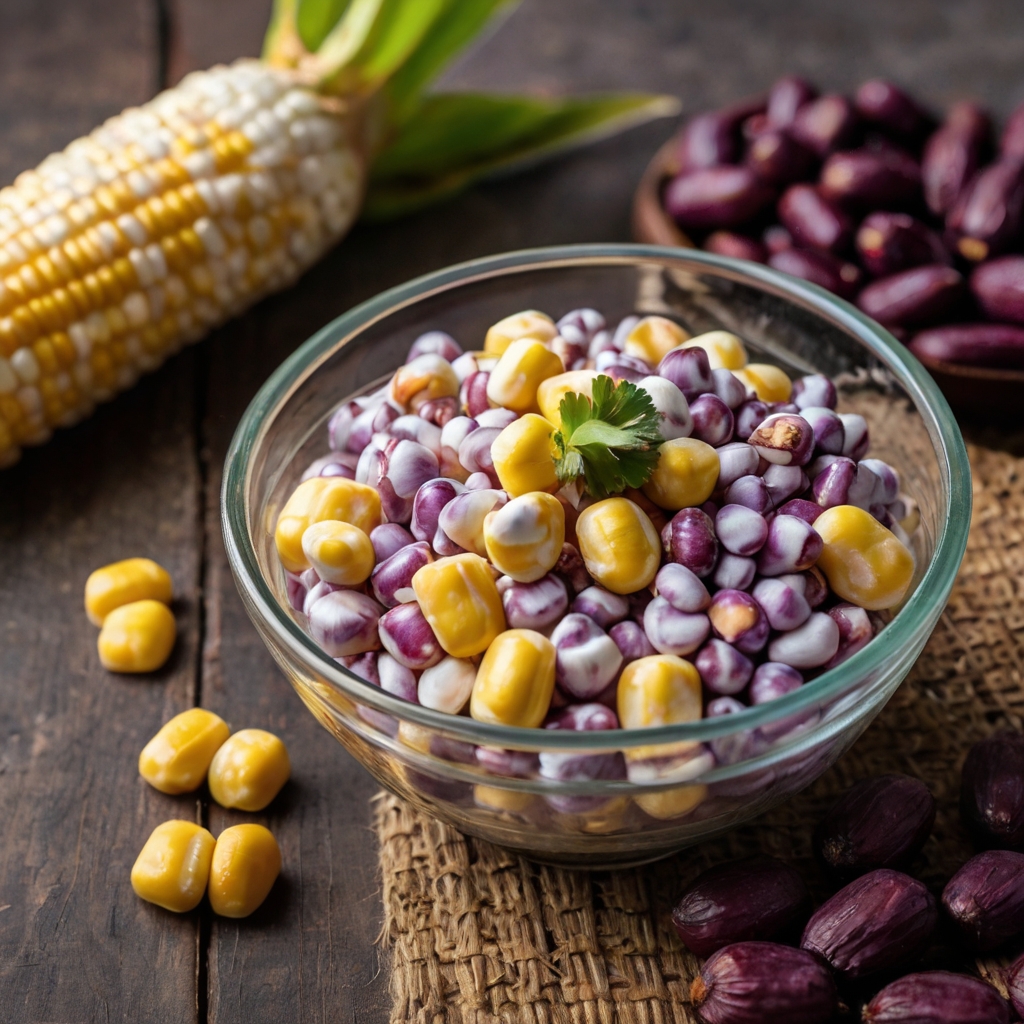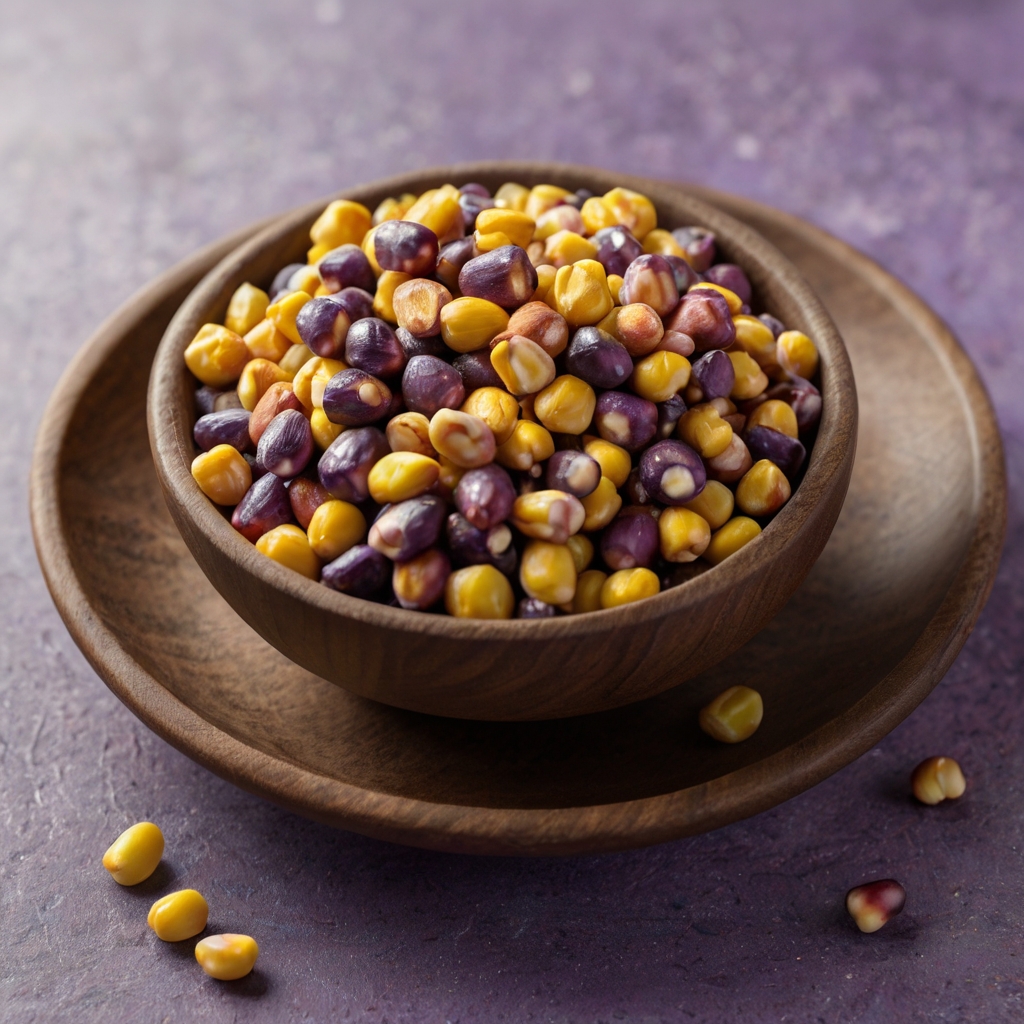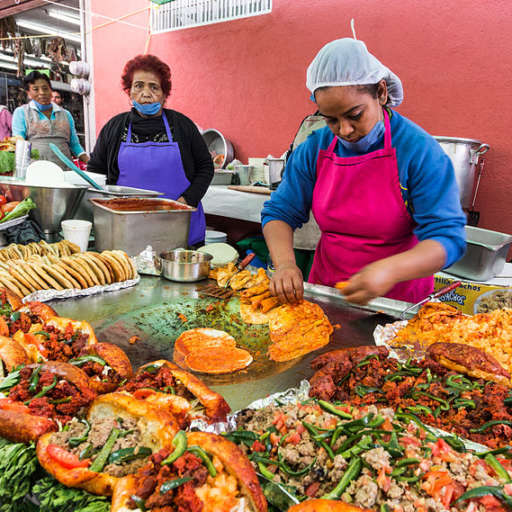Peruvian corn comes in almost every color you can imagine—yellow, orange, red, white, blue, and even a deep purplish-black. This amazing variety creates a stunning visual display and serves as the foundation for countless traditional Peruvian dishes and drinks.
Corn has earned a sacred place in Peru’s cultural heritage, especially among pre-Columbian civilizations like the Inca. These ancient peoples used chicha de jora, a fermented corn beer, during their most important ritual ceremonies. The Andes region produces Chulpe corn with its giant kernels, while the flavorful choclo gets its distinctive taste from cumin and lime seasoning. You won’t find these unique tastes and textures anywhere else in the world. Cancha corn nuts are giant roasted and salted kernels that make a warm, slightly sweet snack. People often enjoy them before meals or with their ceviche. The striking purple corn creates vibrant drinks like chicha morada and sweet treats such as mazamorra morada. Street vendors serve grilled corn with spicy Aji sauce that perfectly balances char and heat.

Table of Contents
- 1 The Origins and Cultural Role of Corn in Peru
- 2 Exploring the Main Types of Peruvian Corn
- 3 Learning About the Main Types of Peruvian Corn
- 4 Corn-Based Drinks That Define Peruvian Cuisine
- 5 Peruvian Corn Snacks You Need to Try
- 6 Corn in Modern Peruvian Dishes and Street Food
- 7 Summing all up
- 8 Here are some FAQs about peruvian corn:
The Origins and Cultural Role of Corn in Peru
Peru’s ancient connection with corn goes back thousands of years. This golden crop has grown into something that surpasses basic food needs. Recent archaeological findings have changed what we know about when corn first showed up in the Andean highlands.
Corn in ancient Andean civilizations
Scientists found that corn made its way from Mexico to the Andean region about 3,500-4,000 years ago. Recent discoveries tell an even older story. Researchers found maize remains at coastal Peruvian sites dating back 6,775-6,504 years – making them South America’s oldest documented corn samples. These early Peruvian corn varieties were mostly popcorn types, known for their seed size, hardness, and how well they popped.
Corn became the foundation of mighty civilizations like the Mochica and Incas. Scientists looked at human bones from Peru’s Ayacucho Valley and found people kept taking maize as their main food about 2,800 years ago. This widespread corn farming became the economic backbone that helped create the Wari state – a complex society with central government before the Incas.
Why corn is sacred in Peruvian culture
Corn grew beyond just food in Andean beliefs. Ancient Peruvians created corn-themed pottery, used it in religious ceremonies, and traded it like money. Many traditional Chimu culture vessels seem to show a Corn God, pointing to corn’s sacred role.
Peruvians often call corn “the mother of all crops.” It stands for nourishment and life’s endless cycle. This deep respect lives on today – many Peruvians see corn as Pachamama’s (Mother Earth’s) sacred gift.
People’s spiritual bond shows in family traditions. They give their first corn ears during special Pachamama ceremonies. This shows thanks for the harvest and promises to care for the land. Chicha de jora, a corn beer, plays a big part in rituals and celebrations. People also use chicha and corn flour to honor their ancestors and gods.
Corn’s role in traditional farming and rituals
Peru’s farmers still use traditional methods that go back to Incan times. They work with the taclla (foot plough), created by early farmers who used their body weight to ready the soil. Some communities still choose oxen and llamas over modern machines to move crops, keeping old farming wisdom alive.
The farming calendar sets specific times to plant and harvest corn, with each season bringing its own rituals. Peru grows more than 55 types of corn – this is a big deal as it means that Peru has more varieties than any other country.
Planting corn among other native crops helps both biodiversity and soil health. This farming style matches the Andean belief in living in harmony with nature. So farmers still make offerings to Pachamama before planting, hoping for good harvests.
Modern Peru keeps its corn traditions strong. Market vendors sell fresh corn next to modern foods. Schools and community centers teach young people how to cook traditional corn dishes. This passing down of knowledge will give Peru’s golden heritage a chance to feed both body and soul for generations to come.

Exploring the Main Types of Peruvian Corn
Learning About the Main Types of Peruvian Corn
Peru’s corn varieties showcase centuries of agricultural innovation in the Andean highlands. Each type brings its own flavors, textures, and uses that have shaped Peru’s food culture, from giant kernels to beautiful purple shades.
Choclo: The giant corn on the cob
Choclo catches your eye right away with kernels so big you can eat them one at a time! This special variety, also known as Peruvian corn or Cuzco corn (named after the old Inca capital), grows well in the Andean highlands. Unlike the sweet corn we know from North America, choclo has a subtle nutty flavor and a chewy, firm texture. Street vendors often serve it hot with a slice of fresh cheese in a popular snack called “choclo con queso”.
Choclo’s uses go way beyond simple dishes. These large kernels are the key ingredient in traditional foods like pepian (a rich corn stew) and pastel de choclo, making them essential in real Peruvian cooking.
Maíz Morado: The purple corn with a purpose
Maíz Morado (purple corn) stands out with its deep violet color. This special variety dates back to pre-Inca times, with art showing its use in the Moche culture (AD 100–700). Farmers first grew it in central Peru’s middle-height regions before it spread to coastal areas and high Andean lands.
This corn isn’t just pretty to look at – it has high levels of anthocyanins, powerful antioxidants you’ll also find in cherries, blueberries, and plums. The kernels contain cyanidin 3-O-glucoside (chrysanthemin), which makes up about 73% of all anthocyanins present. The husks pack even more punch with ten times more anthocyanins than the kernels.
Maíz morado brings amazing health benefits. Its antioxidants help improve blood flow, reduce blood pressure, and lower cholesterol. It also helps with diabetes treatment, makes blood vessels stronger, and boosts circulation.
Maíz Blanco and Amarillo: The base of sacred drinks
Maíz Blanco and Amarillo (white and yellow corn) are the stars in Peru’s culturally important drinks. These types go into making chicha de jora, a corn beer that pre-Columbian peoples like the Inca loved. This special drink was key in their ceremonies and still plays a part in traditions like pagos a la tierra (offerings to Mother Earth).
The giant white corn only grows in certain Andean areas, mostly in Colca and Urubamba (the Sacred Valley of the Incas). Ancient farmers started breeding these crops for extra-large kernels around 1200 B.C., creating new corn types that fit perfectly with the region’s different landscapes and weather patterns.
Maíz Chullpi: The snackable variety
Maíz Chullpi makes the perfect snacking corn with its softer shell and inside. When toasted or fried, it becomes cancha or canchitas—authentic Peruvian corn nuts that come with many traditional dishes.
People love munching on these crunchy kernels with ceviche or as bar snacks. Cooks fry the corn in oil with salt to create an easy and tasty snack with a light toasted flavor.
Mote: Rehydrated corn for daily meals
Mote is more about how it’s prepared than being a specific type. It starts as dried corn kernels (usually white or yellow) that are soaked and boiled until their outer layer starts peeling off. Many Peruvians can’t imagine a meal without it—they say “the table is not set unless there is a dish of mote on the table!”
You prepare mote just like dried beans. After soaking overnight, it needs 2-3 hours of cooking until the kernels get soft and start to “pop”. The cooked mote works great in soups, stews, and even desserts. Up in the Andean highlands, people start their day with “mote pillo” (mote with eggs), one of their favorite breakfast dishes.
Corn-Based Drinks That Define Peruvian Cuisine
Peruvian cuisine showcases corn’s versatility through amazing beverages that capture Andean culture’s spirit. Local communities across Peru turn this simple grain into drinks ranging from sweet refreshments to sacred ceremonial beverages.
Chicha Morada: The iconic purple corn drink
Chicha morada, Peru’s national refreshment, is a non-alcoholic drink made from dried purple corn. This beautiful purple beverage blends antioxidant-rich maíz morado with pineapple, apple, cinnamon sticks, and cloves. People make it by boiling corn with spices for 40-50 minutes and strain out solids before adding fruit and sugar. You can find it in stores, but homemade chicha morada tastes better with its perfect sweet-spicy balance. Many Peruvians get the most flavor from their corn kernels by using them twice, until they break open.
Chicha de Jora: Fermented corn beer of the Incas
Chicha de jora, known as “the nectar of the Incas,” has deep cultural roots going back thousands of years. This light fermented corn beer (1-3% alcohol) starts with germinated maize that releases starches like regular beer making. Old-time brewers would chew the corn to start fermentation using natural enzymes from saliva, but modern methods skip this step. Andean homes hang red flags outside to show they’re a “chichería” selling fresh chicha de jora. The drink’s ritual importance lives on today—Peruvians pour the first sip on the ground saying “Pachamama, santa tierra” as a gift to Mother Earth.
Api: A warm breakfast drink from purple corn
Api morado is a cozy alternative to chicha, perfect for chilly Andean mornings. This thick purple corn drink starts many days in Bolivia and southern Peru. People make it by soaking ground purple corn flour in water and cooking it with cinnamon, cloves, and orange zest until it thickens. The drink has a deep grape-like taste and works well hot or cold. Street vendors usually sell api with buñuelos (deep-fried soft dough), making a classic breakfast combo that keeps you going all day.
Frutillada: A fruity twist on traditional chicha
Frutillada (also called Chicha de Frutilla) puts a fresh spin on regular chicha de jora. This pink drink combines traditional corn beer with strawberries from Peru’s Sacred Valley. You’ll find frutillada in chicherías marked by red banners from November through January. These days, some makers use beet or ayrampo coloring instead of strawberries, but the original strawberry version gives you a sweet-tangy taste with a mild 1-2% alcohol kick.
Peruvian Corn Snacks You Need to Try
Peruvian corn creates amazing snacks that showcase the country’s rich culinary heritage. Simple street foods and traditional treats highlight this versatile grain’s role in Andean cuisine.
Cancha: The original Peruvian corn nuts
Peruvians make their version of corn nuts, called Cancha, from a special corn variety known as maíz chulpe. These pointy dried kernels behave differently from regular popcorn. They pop with heat but stay compact instead of bursting outward. The result is a slightly puffy, toasted snack with an addictive starchy taste. Making Cancha needs just vegetable oil, corn kernels, and salt. Cooks use a heavy-bottomed skillet to heat the oil and cook the kernels until they turn golden brown, which takes about 10 minutes.
Canchitas with ceviche
Canchita has earned its place as the perfect match for Peru’s famous ceviche. These crunchy toasted corn kernels enhance the seafood dish’s texture and flavor. Restaurants serve these kernels in separate bowls next to ceviche. Diners can add the amount they want to create their ideal texture combination. This pairing shows how Peruvian cuisine balances contrasting elements – fresh, acidic ceviche meets warm, crunchy canchita.
Cachangas and humitas
Cachangas bring a unique twist to corn snacks with their anise-flavored fried flatbread form. Cooks roll the dough thin, about the size of a small salad plate. The frying process creates a crispy exterior while keeping the inside soft. Humitas offer steamed corn cakes stuffed with cheese, onions, and herbs. Unlike tamales that use corn flour, humitas’ tender corn pulp creates its own distinct texture and taste.
Pastel de choclo and mazamorra
Pastel de choclo, meaning “corn pie” or “corn cake,” combines sweet corn with hearty fillings. Ground beef, chicken, raisins, black olives, onions, and hard-boiled eggs create its rich interior. The best pastel de choclo should be creamy enough to eat with a spoon. Sweet-toothed food lovers will enjoy mazamorra – a pudding-like dessert. Purple corn, cinnamon, cloves, and a touch of sugar or honey create this traditional treat.
Corn in Modern Peruvian Dishes and Street Food
Peruvian corn’s versatility and distinctive flavor continue to define the nation’s culinary world. This ancient grain remains central to both traditional recipes and modern breakthroughs, showing up everywhere from street carts to upscale restaurants.
Pepian de choclo: A hearty corn stew
The traditional corn stew Pepian de choclo brings comfort in every spoonful with its pre-Hispanic roots. This rich, savory-spicy creation derives its name from “pipuyan” (meaning “to thicken”), which perfectly describes its luscious texture. The dish adapts well to various proteins – chicken thighs, breasts, pork, turkey, or even vegetarian options. Choclo or white corn kernels blended with cilantro leaves create its vibrant sauce, which varies from yellow to green based on regional recipes. Peru’s northern regional cuisine shines through this flavorful dish, seasoned with cumin, aji amarillo, and aromatic vegetables like zucchini.
Choclo con queso: A street food staple
Choclo con queso (literally “corn with cheese”) stands out as Peru’s iconic street food that pairs steamed giant corn with fresh, salty cheese. This simple snack reflects Peru’s agricultural heritage and emerged as a practical meal for farmers and travelers. Local vendors serve the corn boiled or steamed to highlight its natural sweetness alongside creamy cheese. The experience gets better with optional toppings like salt, butter, or spicy ají sauce.
Corn in Peruvian salads and side dishes
Giant Peruvian corn elevates ordinary salads into remarkable dishes. Solterito showcases this ingredient’s versatility in a vibrant salad. Large, chewy kernels mix with fresh cheese, tomatoes, red onion, and sometimes black olives to create this refreshing dish. Goya Giant White Corn provides the authentic texture that separates it from regular corn dishes. “Choclo al comino” offers another tasty option – corn seasoned with butter, cumin, and lime juice serves as an appetizing side dish.
Fusion dishes using Peruvian giant corn
Creative chefs keep finding new ways to use Peru’s distinctive corn varieties. Modern interpretations include Peruvian corn salads with ají amarillo vinaigrette that adds tangy, slightly spicy notes to complement choclo kernels’ substantial texture. Peru’s culinary experts are blending this ancestral ingredient into contemporary cuisine, creating exciting fusion dishes that honor tradition while welcoming new ideas. These culinary creations show how Peruvian corn exceeds time’s boundaries and inspires new generations of cooks with its unique character and adaptability.
Summing all up
Peruvian corn stands as proof of centuries of agricultural breakthroughs and cultural respect. This versatile grain has evolved from a sacred offering to Pachamama to become the life-blood of countless beloved dishes and beverages throughout Andean history. Peru has more corn varieties than any other country worldwide, which shows in its amazing diversity—from the giant kernels of choclo to the deep purple hues of maíz morado.
Each corn type has its own special place in the kitchen. Fresh cheese and choclo make a perfect pair in street food markets. The refreshing chicha morada made from maíz morado quenches thirst across the nation. Of course, the fermented chicha de jora keeps its ancient role in spiritual ceremonies and connects modern Peruvians with their Incan ancestors.
Simple ingredients turn into extraordinary flavors through Peruvian creativity. Take cancha—those addictively crunchy toasted kernels. These humble corn nuts show up alongside sophisticated ceviches in street-side carts and upscale restaurants, showing how corn crosses all social and economic lines.
Modern Peruvian chefs honor this ancient grain. They prepare traditional pepian de choclo and create new fusion dishes. Corn’s lasting presence across Peru’s food scene highlights its role beyond just an ingredient—it’s a cultural symbol.
Learning about Peru’s golden treasure changes how food lovers see corn forever. This extraordinary grain carries the soul of Andean tradition while adapting to modern tastes. It’s a delicious trip through time that continues to engage palates worldwide. Anyone who wants authentic Peruvian flavors should try these distinctive corn varieties that have fed both body and spirit for thousands of years.
Here are some FAQs about peruvian corn:
What is the difference between Peruvian corn and regular corn?
Peruvian corn, especially varieties like choclo, features much larger kernels and a starchier texture compared to regular sweet corn. The peruvian purple corn drink showcases another unique variety with deep violet kernels packed with antioxidants. While regular corn is typically yellow or white, peruvian corn nuts and other products highlight the diverse colors and textures found in Peru’s native corn varieties.
What is Peruvian corn called?
The most famous Peruvian corn is called choclo, known for its enormous white kernels used in dishes like peruvian corn salad. Another well-known variety is maiz morado used to make the vibrant peruvian purple corn drink called chicha morada. These native corn types differ significantly from the peruvian corn nuts sold internationally as snack foods.
Is Peruvian corn the same as hominy?
While both are processed corn products, Peruvian choclo differs from hominy in preparation and texture. The peruvian corn drink tradition uses fresh choclo rather than the nixtamalized corn that creates hominy. However, some peruvian corn nuts undergo processes similar to hominy production, though they maintain distinct flavors from Peru’s native corn varieties.
Is Peruvian corn genetically modified?
Most traditional Peruvian corn varieties like those used in peruvian purple corn drink and choclo-based dishes are ancient, non-GMO cultivars. The peruvian corn salad typically features these heritage varieties that have been cultivated for centuries. While some commercial peruvian corn nuts might use hybridized corn, Peru protects many of its native corn genetics from modification.
What type of corn is used in Mexico?
While Mexico favors white and yellow dent corn for tortillas, Peru’s choclo and purple corn for their signature peruvian corn drink differ significantly. The peruvian corn nuts tradition also uses unique varieties not commonly found in Mexican cuisine. Both countries treasure native corn types, with Peru’s choclo and purple corn being particularly distinct.
What is the most beautiful corn in the world?
Many consider Peru’s purple corn, used in the stunning peruvian purple corn drink, to be the most visually striking variety. The giant-kerneled choclo used in peruvian corn salad also stands out for its impressive size and pearlescent color. These Peruvian varieties outshine ordinary corn in both appearance and their use in unique preparations like peruvian corn nuts and traditional drinks.

